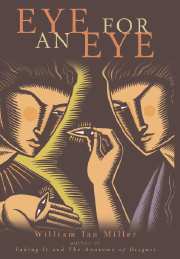Book contents
- Frontmatter
- Contents
- Preface: A Theory of Justice?
- 1 Introductory Themes: Images of Evenness
- 2 The Talion
- 3 The Talionic Mint: Funny Money
- 4 The Proper Price of Property in an Eye
- 5 Teaching a Lesson: Pain and Poetic Justice
- 6 A Pound of Flesh
- 7 Remember Me: Mnemonics, Debts (of Blood), and the Making of the Person
- 8 Dismemberment and Price Lists
- 9 Of Hands, Hospitality, Personal Space, and Holiness
- 10 Satisfaction Not Guaranteed
- 11 Comparing Values and the Ranking Game
- 12 Filthy Lucre and Holy Dollars
- Conclusion
- Notes
- Works Cited
- Index
1 - Introductory Themes: Images of Evenness
Published online by Cambridge University Press: 18 December 2009
- Frontmatter
- Contents
- Preface: A Theory of Justice?
- 1 Introductory Themes: Images of Evenness
- 2 The Talion
- 3 The Talionic Mint: Funny Money
- 4 The Proper Price of Property in an Eye
- 5 Teaching a Lesson: Pain and Poetic Justice
- 6 A Pound of Flesh
- 7 Remember Me: Mnemonics, Debts (of Blood), and the Making of the Person
- 8 Dismemberment and Price Lists
- 9 Of Hands, Hospitality, Personal Space, and Holiness
- 10 Satisfaction Not Guaranteed
- 11 Comparing Values and the Ranking Game
- 12 Filthy Lucre and Holy Dollars
- Conclusion
- Notes
- Works Cited
- Index
Summary
The Scales of Justice
We are used to seeing Justice figured as a strong woman, bearing a sword, sometimes crowned with sprigs of a plant – laurel or grain stalks – blindfolded perhaps, and surely bearing scales. Most of us, I would bet, assume that the scales merely reproduce the message of the blindfold: that justice is impartial, not a respecter of persons, which means it is blind to the social status of the people before it. The blindfold is a late addition to the iconography of Justice. It dates from the early sixteenth century, whereas scales have been associated with Egyptian Maat, Greek Dike, and Roman Lady Aequitas for a couple of millennia longer than that.
The scales overflow with productive meanings – for starters, are they properly represented in Justice's hand as even or tipped? – but the blindfold quickly degenerates into absurdity if we think on it too closely. Do you want to blindfold someone with a sword? It may not be wise to have her unable to see what she is striking, unless you do not give a damn about how much it costs to do justice; collateral damage, though unfortunate, must be borne. Blind justice morphs into blind fury. And how is she supposed to read the scales, if she is blind? This troubled early representers of Justice; some thus gave her two faces like Janus, with the side bearing the sword prudently left unblindfolded.
- Type
- Chapter
- Information
- Eye for an Eye , pp. 1 - 16Publisher: Cambridge University PressPrint publication year: 2005



